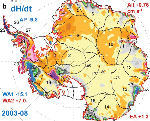A new paper Mass gains of the Antarctic ice sheet exceed losses (Zwally et al 2015) shows that the Antarctic Ice Sheet (AIS) has grown in mass by 82 ± 25 billion metric tonnes of ice per year (Gt/yr) between 2003 and 2008. The lead author Jay Zwally is a NASA glaciologist. The ice gains in East Antarctica and parts of West Antarctica exceeds the losses in coastal drainage systems and the Antarctic Peninsula.
This paper had been reviewed by Jim Steele of San Francisco State University here, and by Steve McIntyre of Climate Audit here. Readers are encouraged to read both articles. NASA news release is here.
The analysis used the Ice, Cloud and land Elevation Satellite (ICESat) data (2003 08) which measure elevation changes of the ice top. Parts of east Antarctica had been gaining mass for the past 10,000 years. Zwally estimates that the ice gain has reduced sea level rise by 0.3 mm/yr. The European Remote-sensing Satellite (ERS) data (1992 2001) give a similar gain of 112 ± 61 Gt/yr.
These results are is stark contrast with the IPCC AR5 's assertion there was high confidence that the Antarctic Ice Sheet had been losing mass at 147 ± 75 Gt/yr over 2002-2011. The IPCC high mass loses are based on satellite data that measures gravity change (GRACE).
However, both methods of measuring Antarctic ice depend on models that estimate Glacial Isostatic Adjustment (GIA),Steve McIntyre which is very uncertain. Steele writes, " Most GIA models assume Antarctica has been rebounding upwards since deglaciation removed the weight of glacial ice. The degree of estimated rebound depends on the region and more importantly 1) uncertain estimates of the mantle 's viscosity below the bedrock and 2) assumptions about the glacial history of Antarctica."
Global Positioning System data (GPS) that measures the bedrock uplift along the coast shows that GIA models overestimate the uplift by 4.9 to 5.0 mm/yr. Recent research shows that previous estimates of Antarctic ice mass during the last ice age was too high, and that melting during the Holocene was overestimated, so that past uplift estimate were too high. The adjustments from the GIA models that are made to the gravity survey (GRACE) direct measurements are about the same magnitude or larger than the total ice mass change, which as Steve McIntyre says, is "hardly a desirable property of the method." McIntyre says, " Over the past decade, the size of generally accepted glacial isostatic adjustments has fallen quite dramatically, with estimates of mass loss falling in conjunction. In retrospect, IPCC AR5 can be seen to have adopted mass loss estimates that were far larger than up-to-date technical literature." Recent estimates to the GIA for Antarctica have been reduced by 120 Gt/yr.
A paper Shepherd et al 2012 using improved GIA estimate shows the GRACE estimate of ice loss of only 57 ± 50 Gt/year during 2004 to 2009, which is much less than the values reported in AR5. The IPCC ignored these and other recent low ice loss results and used only old and discredited higher values. The IPCC estimate of AIS ice loss of approximately 147 Gt/yr over 2002-2011 rely on GRACE estimates using obsolete GIA adjustments that were know by the IPCC authors to be obsolete.
Zwally et al 2015 reports that the new, lower GIA estimates impact the altimeter ice mass estimates by less than 17% of the impact on the gravity ice mass estimates. Since the impact of the problematic GIA adjustments is six times larger on GRACE estimates than altimetry estimates, it is clear that the altimeter estimates are more reliable than the GRACE estimates.
Skeptics have long pointed out the apparent incongruity between IPCC estimates of AIS mass losses and increasing sea ice. The IPCC AR5 reported that "it is very likely" that annual mean Antarctic sea ice extent increased 1.2 to 1.8% per decade during 1979 to 2012. The more accurate altimeter based estimate of AIS mass gain of about 82 Gt/yr is consistent with the increasing sea ice around Antarctica.
